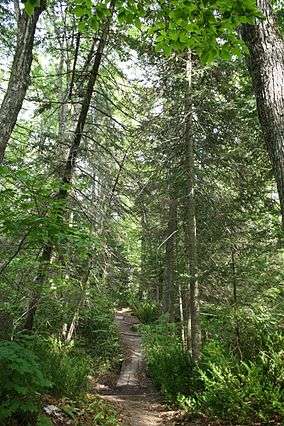Gaylord Nelson Wilderness
| Gaylord Nelson Wilderness | |
|---|---|
|
IUCN category Ib (wilderness area) | |
|
Gaylord Nelson Wilderness on Raspberry Island | |
 | |
| Location | Ashland County, Wisconsin, Bayfield County, Wisconsin, USA |
| Nearest city | Bayfield, Wisconsin |
| Coordinates | 46°57′55″N 90°39′51″W / 46.965278°N 90.664167°WCoordinates: 46°57′55″N 90°39′51″W / 46.965278°N 90.664167°W |
| Area | 33,500 acres (135.6 km2) |
| Established | 2004 |
| Governing body | National Park Service |
The Gaylord Nelson Wilderness is a 35,000-acre (142 km2)[1] wilderness area located within Apostle Islands National Lakeshore, off the Bayfield Peninsula of northern Wisconsin. Of the twenty-two Apostle Islands, the wilderness area fully or partially covers eighteen.
Administered by the National Park Service, this wilderness area is the largest in Wisconsin. It was established in 2004 to preserve the current management practices of the national lakeshore,[2] namely the prohibition of motorized travel on the wilderness islands. It is named for Gaylord Nelson, a U.S. Senator and governor of Wisconsin, who was instrumental in establishing the National Trails System, the Wilderness Act, and Earth Day.[3]
Previously used for logging, farming, and mining during the early 20th century, the islands are returning to a primitive state; evidence of human habitation is still present, albeit mostly obscured by the regenerating forests. The islands' coastlines possess varied geology, where precambrian sandstone has eroded into sea caves, and the resulting sand has formed sandspits, cuspate forelands, tombolos, barrier spits, and beaches.
Ecologically, the islands contain some old growth, but primarily secondary Northern hardwood forest. There are elements of the oak, hickory, and hemlock hardwood forests of the eastern United States, but also features of the Boreal forest typical of Ontario. Larger wildlife on the islands and surrounding area include whitetail deer, black bear, red fox, and coyote. Smaller mammals such as squirrels, beaver, otter, snowshoe hare, and voles are also present. Avian species in the wilderness include waterfowl, ruffed grouse, and woodcock.
The Gaylord Nelson wilderness area provides opportunities for camping, hiking, sailing, kayaking, birdwatching, and fishing.
See also
References
- ↑ Gaylord Nelson Wilderness - Wilderness.net. Retrieved 11 Nov 2011
- ↑ Gaylord Nelson Wilderness - National Park Service. Retrieved 11 Nov 2011
- ↑ Gaylord Nelson - The Wilderness Society. Retrieved 11 Nov 2011
External links
- Official site at National Park Service
- Gaylord Nelson - Wilderness.net
